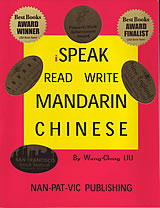| Chapter 1 : The 100 common Chinese sentences for daily conversation. | 1 - 18 |
| Chapter 2 : Introduction : | |
| 1) How to use this book. | 19 - 21 |
| 2) How to read Chinese lines and paragraphs. | 22 |
| 3) Dos and don’ts. | |
| 3.1 Never compare the sentence structures in Chinese with those in English. | 23 |
| 3.2 Learn Chinese grammar and the method to make Chinese sentences the Chinese way --- learn their daily expressions and idiomatic usages. | 24 |
| 4) Build up your vocabulary from verbs. | 25 |
| 5) Syntax. | 26 - 28 |
| Chapter 3 : Chinese Language vs English Language | |
| I) Differences in Pronunciation. | 29 |
| II)Chinese Grammar vs English Grammar. (Explanation, key words, usage and examples) | |
| 1) Location of Chinese Adverbs. | 30 |
| 2) Omission of the verb “To Be” in some cases. | |
| 3) Tenses in Chinese language are NOT as important as in English. Chinese
people use mainly the Present Tense, Past Tense, Present Perfect Tense
and Progressive Tense. | 31 |
| 4) Nouns in Possessive Case. | 32 |
| 5) Omission of the word [de] in the text. | 32 |
| 6) Abbreviations in Chinese words. | 33 - 34 |
| 7) Words used to express negation in Mandarin. | 35 - 36 |
| Drills on words of negation in Chinese. | 37 |
| Chapter 4 : Brief introduction about the Eight Parts of Speech in Chinese Grammar. | |
| - Lesson 1 : Pronoun. | 38 – 39 |
| Drills on Pronouns | 40 |
| - Lesson 2 : Verbs. | 41 - 48 |
| Drills on Tenses of Verbs | 49 |
| Active Voice & Passive Voice | 50 - 51 |
| Drills on Verbs | 52 |
| - Lesson 3 : Nouns. | 53 - 56 |
| Drills on Nouns | 57 |
| - Lesson 4: Adjectives. | 58 - 60 |
| Drills on Adjectives | 61 - 62 |
| Adjective Phrases | 63 - 64 |
| Adjectives : the numbers. | 65 - 67 |
| Drills on the numbers | 68 - 69 |
| - Lesson 5 : Adverb. | 70 - 72 |
| Drills on Adverbs | 73 |
| - Lesson 6 : Conjunction. | 74 - 75 |
| Drills on Conjunctions | 76 |
| - Lesson 7 : Preposition. | 77 - 80 |
| - Lesson 8 :Exclamation. | 81 - 82 |
| Drills on Conjunctions, Prepositions and Exclamations | 83 - 84 |
| Chapter 5 : How to ask a question in Chinese? | 85 - 90 |
| If you know how to make simple sentences in Chinese, you’ll be able
to speak Mandarin right away. Asking a question is the first step to starting
a conversation or to understand what people wish to know about you. | |
| The 7 W’s : they are the seven key words used for asking questions. | 91 - 96 |
| Drills on the Interrogatives and the 7W’s | 97 – 98 |
| Chapter 6 : Explanation of some useful Chinese words. | 99 – 145 |
| Drills on the word ‘qing’ . | (P.105) |
| Drills on the words “ de, de, de ” | (P.115) |
| Drills on the words “le” and “guo”. | (P.123) |
| Drills onexpressions “na, na-li, na-me, na-yang” etc. | 136 - 137 |
| Chapter 7 : Chinese cultural aspects. | |
| - Etiquette that westerners should know when they make friends
with Chinese people. | 146 - 148 |
| - Chinese characters and Chinese calligraphy. | 149 - 150 |
| Drills for fun. | 151 |
| - A pair of chop sticks. | 152 - 153 |
| - Countries/people/money. | 154 |
| - Personalities of Chinese people shown in poems. | 155 - 165 |
| Drills - just for fun. | 166 - 167 |
| Drills that you love. | 168 - 170 |
| - The LAST PAGE of this book. | 171 |
| Appendices : | |
| - Four Sizes for some Chinese characters. | 172 - 180 |
| - Chinese punctuation. | 181 |
| - Four ways to express and write Chinese numbers. | 182 - 187 |
| - The Classifiers: they play an important role in Chinese language. | 188 - 190 |
| - Simplified Chinese Characters vs Traditional Chinese Characters. | 191 - 195 |
| - Common Chinese names and family names. | 196 - 197 |
| - The 4-word Chinese idioms. | 198 - 199 |
| - Useful vocabulary in daily life. | 200 - 209 |
| - Useful Verbs in daily conversation. | 210 - 215 |
| - Chinese Phonetics: | 216 |
| I have invented a new way to write phonetics to make it more precise to
pronounce Chinese words, and it is much easier for westerners to follow: | |
| - Chinese Phonetic Table. | 217 - 219 |
| - A skier’s diagram to show the 4 tones in Mandarin. | 220 |
| - The four tones in Mandarin. | 221 - 222 |
| - The Light Tone. | 223 - 224 |
| *** Suggested answers for the Drills. | 225 – 244 |
| *** Answers for the Riddles | 245 |
| Bibliography. | |

